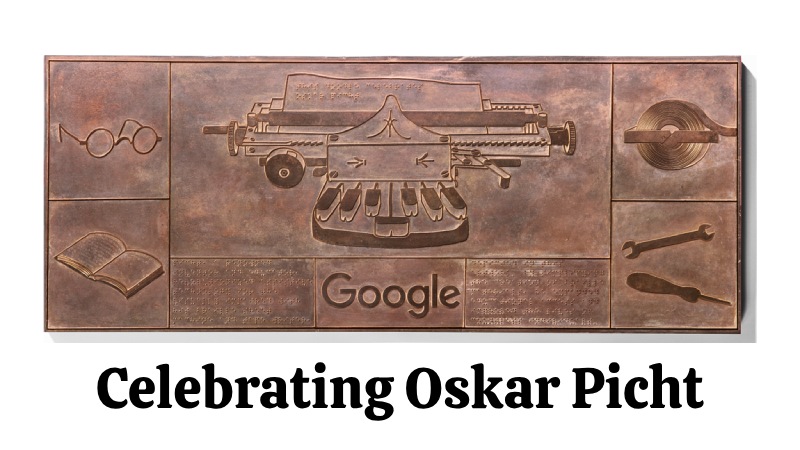Today’s bronze relief and bespoke Google Doodle, made by Kiel-based artist Ute Dietz, celebrates Oskar Picht, a German teacher and inventor who created the first braille typewriter for the Blind. His amazing invention empowered blind people to compose braille with more speed and proficiency. Additionally, he was an inspiring advocate who advocated for the inclusion of people with vision impairments in society.
The Doodle artwork is a bronze relief sculpture and the imagery is intended to make an equitable, legible, and fascinating tactile Google Doodle insight for blind individuals — the first of its kind in Doodle history!
The artwork likewise includes Braille text that explains Oskar Picht’s achievements. The relief is permanently installed at the first Accessibility Discover Center in the Google Munich offices. On September 23, 1907, Picht achieved a gold medal at the International Typewriter Exhibition in Venice for his accomplishments. Here are some interesting and fun facts about Oskar Picht.
Here is a look at the life and work of Oskar Picht.
Interesting Facts about Oskar Picht
- Oskar Picht was the inventor of a braille typewriter for blind individuals.
- Picht was born in Hamburg, Germany in 1871. Picht was the son of the master baker Wilhelm Picht and his wife Hermine.
- He attended Pasewalk’s town school and later transferred to the higher boys’ school. From 1886 to 1891 he was at the state teacher training college in Pölitz.
- After schooling, Oskar Picht immediately became an educator and later tracked down an interest in blind education.
- From 1891 he was an educator for three years in Marienthal, then in Bahn in the Greifenhagen district. Then Picht decided to become a teacher for the visually impaired.
- He procured fundamental knowledge from 1897 to 1899 at the State Institute for the Blind in Berlin-Steglitz. After his training, he worked there for several years.
- Oskar Picht created the first operable German braille sheet-fed machine in 1899 (for paper sheets; consequently the name), for which he got the first utility model on May 6, 1901. Picht had registered nine more utility models by 1932.
- After decades of upgrades and changes, Picht was granted one more patent for it in 1932. The redesigned machine had six keys with various combinations of depressed dots that could indent a sheet of paper.
- Oskar Picht married Margarete Charlotte Conrad on April 24, 1902, and they had three children.
- Beyond inventing, Picht stayed a dedicated supporter of blind education. He was director of both the Blind Institution in Bromberg (1910-1912) and his alma mater (1920–1933).
- He created the first German braille strip recorder in 1910, which was abbreviated as a steno machine, and used rolled paper strips as a medium.
- In 1912 (different sources say 1910) Oskar Picht became director of the Provincial Institute for the Blind in Bromberg, and from 1920 to 1933 Picht was director of the State Institute for the Blind in Berlin-Steglitz.
- Picht was the first German to speak about blindness on radio in 1924. He had the first blind film Our Blind and Their World made.
- After retiring Picht resided initially in Schloßstraße in Steglitz and moved to the Potsdam-Rehbrücke blind home at the end of 1944.
- He spent his life working to ensure blind individuals approached quality training, state-of-the-art technology, and equal opportunity.
- Oskar Picht died at the age of 74.
- On 23rd September 2024, Google featured a bronze relief Doodle on its homepage to celebrate Oskar Picht. On this day in 1907, Picht received a gold medal at the International Typewriter Exhibition in Venice for his achievements.
Honors and Awards
- Golden medal at the International Typewriter Exhibition in Venice in 1907
- Cross of Merit for War Blind Aid, 1917
- Honorary member of the Blind Association for the Provinces of Brandenburg and Kurmark, 1933
- Renaming of the Pasewalker Gymnasium to Oskar-Picht-Gymnasium Pasewalk, November 1999
- Beginning around 2000, the Oskar Picht Prize has been awarded to high school graduates for remarkable social and academic achievements.
